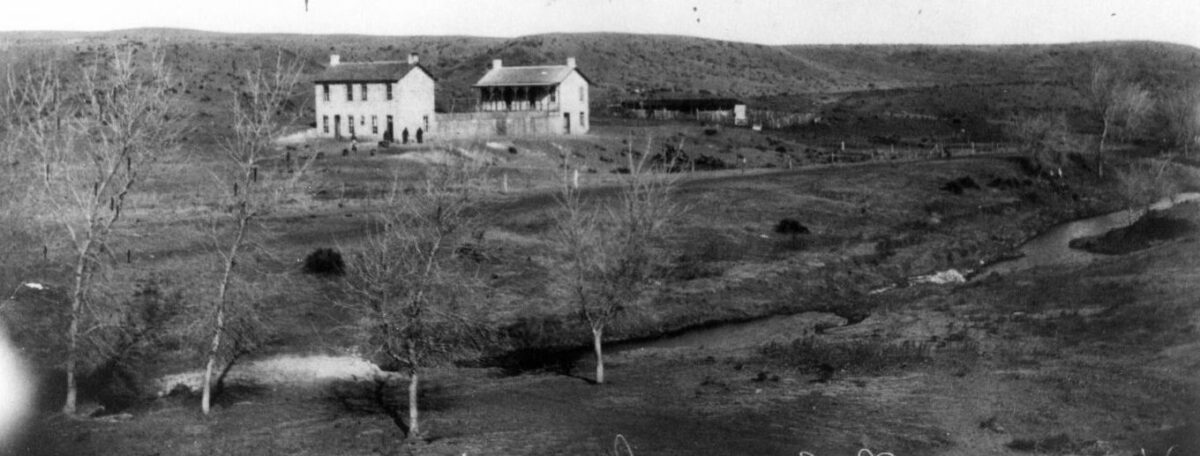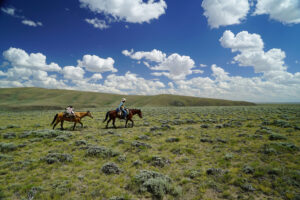In the spring of 1883, a group of cowboys walked off the job in Oldham County, in northwest Texas by the New Mexico line. The strike came about because Gilded Age business practices were moving West, overturning the traditional close relationship between ranch owner and ranch hand. By the 1880s, ranching had become a large and lucrative business, attracting investors from the East and from Europe. Absentee owners operated through hired managers, visiting their holdings infrequently, if at all. They knew little about the cowboy and cared even less.
The typical cowboy was accustomed to working pretty much on his own terms for a ranch owner or manager with whom he was in more or less daily contact. If the cowboy had ambitions of starting his own spread, he might take part of his pay in calves, brand mavericks and run his own cattle and horses with those of the ranch. With corporate ranching, however, he became merely an employee, almost a servant in the view of outside investors. He was forbidden to keep his own brand and this, by extension, ended the practice of mavericking. Likewise, he was not allowed to run his own horses or cattle on the ranch. Although beef prices were on the rise, the cowboys did not share in the prosperity.
Wages for cowboys were generally frozen in place, from $30 to $40 a month for an ordinary hand, $45 for a top hand and up to $125 a month for a wagon boss. The work week often exceeded 100 hours. Fences now contained the herds, eliminating the need for full-time crews. Most employment became seasonal, with extra hands hired during peak work periods and discharged during slack times.
The new style of ranching was formalized in Texas in 1881, by the establishment of the Panhandle Cattlemen’s Association, an organization that included only the owners and managers. The fact that the cowboys were not represented only widened the gulf between them and their employers. Faced with a united front in management, the cowboys also began to solidify. The traditional loyalty between hand and rancher was ruptured.
Perhaps the most highhanded—or at least the most visible—of the big ranchers was W.M.D. Lee of Leavenworth, Kan., who had bought out small owners, forced them off the land and reportedly burned their improvements. Together with Lucien Scott, he controlled the 80,000-acre Lee-Scott Cattle Company, popularly known as the LS. Lee believed the best way to maximize profits was to drive yearlings and 2-year-old cattle from Texas to Montana Territory, where they would fatten up for shipment to Midwestern markets. Accordingly, he decided to organize a spring drive to free range on the Yellowstone River of Montana.
The first inkling of trouble came in the Oldham County sheriff’s election in 1882. The cowboys banded together to support Jim East against Cape Willingham. Both men had good records in handling local badmen, and Willingham had no particular ties with the big ranchers. Nevertheless, the cowboys believed that East, who had once worked as a hand, would be more sympathetic to their plight. East scored a narrow victory, and the area cowboys began to see hope in solidarity.
Throughout the winter of 1882-83, the situation simmered. Then, on March 10, 1883, agents from the ranches met at Tascosa, 35 miles from LS headquarters and the only town of any consequence, and agreed to implement Lee’s plan of a drive to Montana Territory. Two crews, from La Junta, New Mexico Territory, and Adobe Walls, Texas, would move mixed herds to Cheyenne Creek on the LS range, which would be the starting point of what promised to be a grueling drive north in May.
The ranchers had reckoned without the hands, and particularly without the wagon bosses, who ran mobile outfits or “wagons” that followed drift cattle and herded them back to the home ranges. Tom Harris was wagon boss for the LS, J.W. “Watty” Peacock for the LIT and Roy Griffin for the LX. Faced with a long drive to Montana Territory, they gathered together their crews and drew up an ultimatum, signed by the three wagon bosses and 21 “cowboys of the Canadian River,” and sent to all the ranch managers. It demanded a minimum wage of $50 per month for hands and “good cooks,” and $75 a month for anyone running an outfit. The managers were given until March 31 to comply.
Of the group, Harris had the most to lose. The LS already paid him $100 a month, $25 more than the ultimatum demanded for wagon bosses. Virtually all the 24 men who signed the ultimatum had permanent rather than seasonal positions with the ranches.
Nevertheless, they formed a loose association with Harris as chairman, and established a small strike fund. In Tascosa, the merchants offered to assist any cowboy who ran short of money. Then, the strikers set about trying to convince other area cowboys to join the cause. Ultimately, five ranches—the LS, LX, LIT, T-Ancho and LE— were affected.
Informed of the strike, Lee rushed down from Kansas and found there was no unified response from the ranches. He urged the others to accede to the wage demands and get the hands back to work in time for the upcoming roundup. Once the roundup was over, Lee contended, the strikers could be singled out and fired, and replaced with hands hired at the old rate.
The next morning, Lee tried to negotiate with Harris. When he held firm, Lee fired him, along with every other LS hand involved in the strike. The LIT offered a lower rate than demanded, and when the hands refused, they also were fired. The management of the LE and T-Anchor summarily discharged all cowboys involved in the strike. With time on their hands and money in their pockets, they drifted into Tascosa, where the businessmen were willing to help them pass their time and spend their money—at least until their funds and credit were exhausted.
Within two months, it became obvious the strike was failing. The striking cowboys had spe
nt all their money in Tascosa, and found their erstwhile friends in town less than sympathetic. At first, most of the ranchers were accommodating; even the intractable TAnchor gave in and offered new hands $50 a month. Once the roundup was finished, however, wages were cut to prestrike levels. The Panhandle Cattlemen’s Association then complied a list of troublesome cowboys, who were discharged and blacklisted.
The strike failed in part because the ranchers presented a more or less united front, whereas the individualism of the cowboys prevented them from doing likewise. Many of the hands remained loyal to their employers, and the practice of firing the strikers was enough to intimidate others. Fencing had created a surplus of unemployed cowboys, and once the roundup was finished, the ranchers could easily afford to discharge any who had given them trouble. Indeed the LS imported virtually an entire new work force from outside Texas, and promoted key loyal employees to the position of wagon boss.
Corporate ranching was here to stay. The power of the ranchers was established to such a degree that in 1888, the consortium-owned XIT could implement a set of “General Rules” that governed virtually every aspect of a cowboy’s work and life. The Gilded Age had arrived in the West.
Originally published in the June 2008 issue of Wild West. To subscribe, click here.





